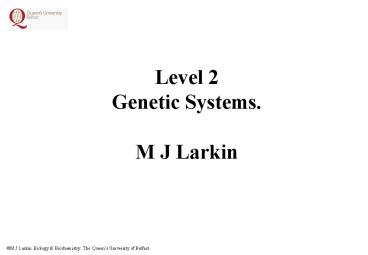Level 2 Genetic Systems. M J Larkin PowerPoint PPT Presentation
1 / 17
Title: Level 2 Genetic Systems. M J Larkin
1
Level 2 Genetic Systems.M J Larkin
- M J Larkin Biology Biochemistry. The Queens
University of Belfast.
2
Dr Mike Larkin - Communication
- MBC Room 113
- xt 2288 (Belfast 972288 Diverted to the DKB)
- DKB Questor Centre Room 318a
- 3rd Floor Microbiology Laboratory
- xt (90977) 4390 or (90977)4388 lab or (9033)
5577 office - Email m.larkin_at_qub.ac.uk
- Pigeon hole in Biology Biochemistry office
- ALWAYS LEAVE MESSAGE and HOW TO CONTACT YOU!
3
Dr Mike Larkin - Communication continuedWWW
PAGES
- http//www.qub.ac.uk/mlpage/page1/index.html
- http//www.qub.ac.uk/mlpage/courses/level2/page.ht
ml
4
Course Theme reminder
- Half of the course dedicated to Microbial
Genetics. Primarily Prokaryote Genetics. - An introduction to bacteria and their genetic
systems.
- Transfer of genes BETWEEN cells in bacteria
- Bacteriophages and plasmids (JQ)
- The fate of DNA WITHIN bacterial cells
- Mutation, recombination, repair, transposition
(ML) - Introduction to genomics and genome mapping
(ML)
5
Reading
- There are many texts with clear explanations e.g.
- Maloy S R et al (2001) Microbial Genetics. 4th
Edition Jones and Bartlett. ISBN 0867202483
QH434/MALO - A comprehensive text and good
introduction 2004 edition due out - Winter P et al (1998)Instant Notes in Genetics.
OxfordBIOS Scientific. ISBN 1859961665
QH440.2/WINT - Not a great coverage of bacterial
genetics but useful nevertheless for
recombination - A good primer text for this part of the course is
Dale J.W. (2004) Molecular Genetics of Bacteria.
5th Edition Wiley ISBN 047085085X QH434.D35. - ? DIRECTED READING will be indicated.
6
Lectures
- Introduction. The basis of diversity
- Mutation, homologous recombination and repair (3
lectures) - Non-homologous recombination
- Mechanisms of transposition (2 lectures)
- Genomics and genome mapping
- Pre-genomic techniques
- Prokaryote genome sequencing (2 lectures)
- Revision tutorial
7
Practicals Aims
- 1. Phage restriction
- Observe phage restriction and consider the
implications of this phenomenon in nature. - Acquire the skills needed to cultivate and titre
phage in practice - 2. Phage co-transduction
- Demonstrate the close linkage of two bacterial
genes by transductional mapping - Observe the connection between RecA function and
DNA repair - 3. Conjugation and transposition
- Demonstrate plasmid conjugation
- Demonstrate Insertion Sequence transposition/coint
egration
8
Introduction the basis of diversity.
LECTURE
- A. What you should know
- B. Terminology
- C. Breeding systems
- D. Types of mutation
- E. Reversion and suppression
- F. Mechanisms of mutation
- G. DNA damage repair
- H. Homologous recombination
- I. Homologous recombination and repair
1
2
3
9
Introduction
- A. What you should know.
- From Level 1 Courses
- The basis of the genetic code
- DNA replication
- The structure of the bacterial chromosome
- ? Maloy and Dale cover introductory material
well. - ? DNA structure and basis of code well covered
in Winter A1
10
Chromosomal replication is bidirectional
Cairns (1963) and Rodriguez (1973) Autoradiography
- 3H labelled DNA
11
The structure of the bacterial Chromosome
Growing cells showing Geimsa stained
condensed chromosome
Lysed E.coli cell (lysozyme)
12
Introduction cont.
- B. Terminology. See Practical schedule.
- The biggest source of confusion in practice
- Strains given numbers e.g. AB1157
- Mutant genotype written as e.g. arg lac Z
- Phenotype written as e.g. Arg or Lac Z
- (?C1857) or (P1Cm ) Lysogenic or cells carrying
these phage - (pOXKm) cells carrying this plasmid
- srlCTn10 indicates presence of transposon (or
IS) in this gene - Mutant or Mutation
- Auxotrophic or Prototrophic
- Mutant selection or mutant screening
- ? Dale Ch 2, Glossary and appendices are very
useful.
13
Introduction cont.
- C. Breeding Systems.
- Eukaryotes possess a SEXUAL CYCLE
?
?
DIPLOID 2n
HAPLOID 1n
14
C. Breeding Systems. cont.
- Variation arises from from
- Mutation, recombination and random assortment
E.g Two Chromosomes randomly assorted.
4 x possibilities at Meiosis
HAPLOID 1n
DIPLOID 2n
3 Chromosomes --------- 16 possibilities n
chromosomes ---------- 2n possibilities
15
C. Breeding Systems. cont.
- Humans have 223 POSSIBILITIES !
- Assuming 2 -3 crossovers per chromosome (i.e.
about 60 in total) (223)60 variants possible
in Meiosis ! - Mutation rate may be only 1 in 20,000 to 200,000
per chromosome. - Mutation adds variants at a low rate. If too
high then a high GENETIC LOAD. Therefore - Meiosis increases overall variation at a high
frequency without a detrimental Genetic Load.
16
C. Breeding Systems. cont.
- What about Prokaryotes ?
- No MEIOSIS possible
- Asexual reproduction
- Single Chromosome with plasmids
- Genetic recombination NOT associated with
reproduction - Mutation rate at single loci about 1 in 108 to
1010 per cell per generation - How is variability generated then ?
- At the gene transfer population GENE POOL level
- Complex mutation/recombination systems within
cells
17
The basis of diversity in bacteria
- Recombination
- Homologous
- Non-homologous
- Rearrangements/transpositions
- Deletions
- DNA Replication
- Mutation
- Repair
DNA Transformation
Plasmid Conjugation
Phage Transduction

